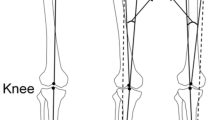Abstract
The objective of the study was to evaluate the reliability of frontal plane lower limb alignment measures using a landmark-based method by (1) comparing inter- and intra-reader reliability between measurements of alignment obtained manually with those using a computer program, and (2) determining inter- and intra-reader reliability of computer-assisted alignment measures from full-limb radiographs. An established method for measuring alignment was used, involving selection of 10 femoral and tibial bone landmarks. (1) To compare manual and computer methods, we used digital images and matching paper copies of five alignment patterns simulating healthy and malaligned limbs drawn using AutoCAD. Seven readers were trained in each system. Paper copies were measured manually and repeat measurements were performed daily for 3 days, followed by a similar routine with the digital images using the computer. (2) To examine the reliability of computer-assisted measures from full-limb radiographs, 100 images (200 limbs) were selected as a random sample from 1,500 full-limb digital radiographs which were part of the Multicenter Osteoarthritis Study. Three trained readers used the software program to measure alignment twice from the batch of 100 images, with two or more weeks between batch handling. Manual and computer measures of alignment showed excellent agreement (intraclass correlations [ICCs] 0.977–0.999 for computer analysis; 0.820–0.995 for manual measures). The computer program applied to full-limb radiographs produced alignment measurements with high inter- and intra-reader reliability (ICCs 0.839–0.998). In conclusion, alignment measures using a bone landmark-based approach and a computer program were highly reliable between multiple readers.




Similar content being viewed by others
References
Cerejo R, Dunlop DD, Cahue S, Channin D, Song J, Sharma L (2002) The influence of alignment on risk of knee osteoarthritis progression according to baseline stage of disease. Arthritis Rheum 46:2632–2636
Sharma L, Song J, Felson DT, Cahue S, Shamiyeh E, Dunlop DD (2001) The role of knee alignment in disease progression and functional decline in knee osteoarthritis. JAMA 286:188–195
Cooke TD, Li J, Scudamore RA (1994) Radiographic assessment of bony contributions to knee deformity. Orthop Clin North Am 25:387–393
Hsu RW, Himeno S, Coventry MB, Chao EY (1990) Normal axial alignment of the lower extremity and load-bearing distribution at the knee. Clin Orthop Relat Res 255:215–227
Tetsworth K, Paley D (1994) Malalignment and degenerative arthropathy. Orthop Clin North Am 25:367–377
Issa SN, Dunlop D, Chang A et al (2007) Full-limb and knee radiography assessments of varus–valgus alignment and their relationship to osteoarthritis disease features by magnetic resonance imaging. Arthritis Rheum 57:398–406
Cooke TD, Sled EA, Scudamore RA (2007) Frontal plane knee alignment: a call for standardized measurement. J Rheumatol 34:1796–1801
Cooke TDV, Scudamore A (2003) Healthy knee alignment and mechanics. In: Callaghan JJ, Rosenberg AG, Rubash HE, Simonian PT, Wickiewicz TL (eds) The adult knee. Williams & Wilkins, Philadelphia, pp 175–186
Chao EY, Neluheni EV, Hsu RW, Paley D (1994) Biomechanics of malalignment. Orthop Clin North Am 25:379–386
Cooke TD, Scudamore RA, Bryant JT, Sorbie C, Siu D, Fisher B (1991) A quantitative approach to radiography of the lower limb: principles and applications. J Bone Joint Surg Br 73:715–720
Prakash U, Wigderowitz CA, McGurty DW, Rowley DI (2001) Computerised measurement of tibiofemoral alignment. J Bone Joint Surg Br 83:819–824
Sled E, Costigan P, Cooke TDV, Sheehy L, Hundt H, Qiu M (2005) Measuring malalignment in knee OA [abstract]. Osteoarthritis Cartilage 13:S120
Hankemeier S, Gosling T, Richter M, Hufner T, Hochhausen C, Krettek C (2006) Computer-assisted analysis of lower limb geometry: higher intraobserver reliability compared to conventional method. Comput Aided Surg 11:81–86
Rozzanigo U, Pizzoli A, Minari C, Caudana R (2005) Alignment and articular orientation of lower limbs: manual vs computer-aided measurements on digital radiograms. Radiol Med 109:234–238
Specogna AV, Birmingham TB, DaSilva JJ et al (2004) Reliability of lower limb frontal plane alignment measurements using plain radiographs and digitized images. J Knee Surg 17:203–210
Takahashi T, Yamanaka N, Komatsu M, Ogawa Y, Yoshida S, Yamamoto H (2004) A new computer-assisted method for measuring the tibio-femoral angle in patients with osteoarthritis of the knee. Osteoarthritis Cartilage 12:256–259
Sailer J, Scharitzer M, Peloschek P, Giurea A, Imhof H, Grampp S (2005) Quantification of axial alignment of the lower extremity on conventional and digital total leg radiographs. Eur Radiol 15:170–173
Sanfridsson J, Ryd L, Eklund K, Kouvaras Y, Jonsson K (1996) Angular configuration of the knee: comparison of conventional measurements and the QUESTOR Precision Radiography System. Acta Radiol 37:633–638
Yoshioka Y, Siu D, Cooke TD (1987) The anatomy and functional axes of the femur. J Bone Joint Surg Am 69:873–880
Yoshioka Y, Siu DW, Scudamore RA, Cooke TD (1989) Tibial anatomy and functional axes. J Orthop Res 7:132–137
Paley D (2003) Principles of deformity correction. Springer, New York
Acknowledgments
The second study, using full-limb radiographs, was supported by the National Institutes of Health Grants AR47785 and AG18820 and MOST Ancillary Study Grant AP07-04. The authors wish to acknowledge the contribution of Mr. Christopher Wale, BSc (I-M Innovations, Inc.), in the design of the computer software tools and analysis program. The support of OAISYS Inc. in provision of the Horizon Surveyor Software Program used in these studies is appreciated.
Conflict of interest statement
T. Derek V. Cooke, President and Principle Share Holder of OAISYS Inc.
Author information
Authors and Affiliations
Corresponding author
Rights and permissions
About this article
Cite this article
Sled, E.A., Sheehy, L.M., Felson, D.T. et al. Reliability of lower limb alignment measures using an established landmark-based method with a customized computer software program. Rheumatol Int 31, 71–77 (2011). https://doi.org/10.1007/s00296-009-1236-5
Received:
Accepted:
Published:
Issue Date:
DOI: https://doi.org/10.1007/s00296-009-1236-5




